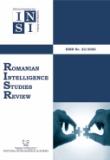SOVIET RUSSIA AND THE “HYBRID WARFARE” AGAINST ROMANIA BETWEEN WW I AND WW II
SOVIET RUSSIA AND THE “HYBRID WARFARE” AGAINST ROMANIA BETWEEN WW I AND WW II
Author(s): Ioan Codruţ LucinescuSubject(s): Diplomatic history, Military history, Security and defense, Interwar Period (1920 - 1939), History of Communism, Peace and Conflict Studies
Published by: National Institute for Intelligence Studies
Keywords: Romanian Army; the General Staff; First World War; Soviet Russia; Romanian intelligence services; interwar period; the Department for General State Security; hybrid warfare; Romanian Communist Party;
Summary/Abstract: World War I led to changes both on a European and a global level. Romania is a significant case/example considering the fact that in 1918, after the fall of the multinational empires, it achieved the goal of national unity. In the following years, the Romanian state promoted the peace established then, in order to strengthen its territorial integrity and alliances. The institutions of the national security system worked, since the end of the military actions, to fulfill this strategic objective. Both the army and the national intelligence services were confronted with complex threats. “Great Romania” had, at the time, three neighbouring countries with an obvious revisionist foreign policy and territorial claims – Hungary, Bulgaria and Soviet Russia. By far the most dangerous enemy (both in terms of force and means) was the Soviet Union which never accepted the territorial losses of the Tsarist Empire and the loss of Bessarabia. Lenin’s Russia and then Stalin’s Soviet Union attempted, in the two decades that separated WW I and WW II, to destabilize the Romanian state through means and methods that echo the modern “hybrid warfare” – from propaganda performed by the communist movement aimed at changing the constitutional order, to various attempts to ignite peasant revolutions (as a pretext for the Red Army intervention), and factory strikes, to an intensive espionage activity. The paper aims to analyse on the one hand the ample subversive actions of the soviet secret services and, on the other, to look at the countermeasures that the Romanian intelligence structures adopted for their annihilation.
Journal: Romanian Intelligence Studies Review
- Issue Year: 2020
- Issue No: 23
- Page Range: 104-115
- Page Count: 12
- Language: English

